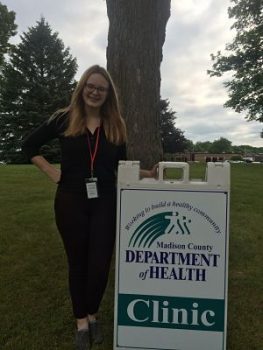Submitted by Victoria Rykaczewski ’20, one of 30 students doing community-based research this summer as a Fellow in the Upstate Institute Summer Field School.

In an increasingly complex and data driven world, information collection and distribution is often one of the most powerful tools health workers have to address community health issues. As a fellow with the Upstate Institute at the Madison County Department of Health (MCDOH), I had the opportunity to work with the Prevent team and their community partners to collect and disseminate health information to improve community health outcomes within Madison County. While most people probably know what their local health department does, they probably don’t know how. But during my time at the Madison County Department of Health, I learned first hand how local health departments turn state and federal law into action that makes a real difference in the lives of the people they serve. Often through collaboration with a wide variety of community partners, one of the most important tasks assigned to a local Health Department is to collect health and population data and then use that information, along with the latest medical research and state and federal guidelines, to communicate a clear and concise message to the public. This summer, I am working on three different projects that each illustrate the different ways that public health workers use information to effect change within their community by gathering data from community members and key stakeholders, administering public information campaigns, and keeping providers up-to-date on recent changes to laws and medical research.
Before they can even begin their work, public health workers need to have a strong sense of the issues that are facing their community. One of the most important tools local health departments use to gather this data is the Community Health Assessment. A Community Health Assessment (CHA) is a highly collaborative process designed to bring together community stakeholders, health networks, providers, public officials, non-profit organizations, and everyday citizens, to evaluate the state of health within their community. This information is then used to create a Community Health Improvement Plan (CHIP), designed to leverage the community’s strengths to better address ongoing health challenges. This summer, MCDOH conducted a county wide phone survey and several focus groups with community members to hear directly from Madison County residents. I was responsible for creating all materials necessary for the focus groups including the discussion guide, question line, and facilitator training, at the direction of the Madison County CHA steering committee. I will also be facilitating a focus group within my own community in Hamilton, NY, and help compile and analyze the resulting data.
Gathering data, however, is only the first step for the Madison County Department of Health. Once they have identified a problem, they then need to leverage the information, medical research, and state policies in order to solve it. Often this means reaching out to the public directly through public information campaigns, like the lead poisoning prevention program that I helped update this summer. Children need to be tested for lead in their blood at age 1 and 2 to screen for blood lead poisoning because lead poisoning, especially in young children, can lead to permanent health and developmental problems including stunted growth and impaired cognitive abilities. However, it can sometimes be difficult for parents to take their young children to get their blood drawn. Often the experience can be traumatic for both the child and parent, and it can be even more difficult for families that don’t have access to reliable transportation or an unpredictable work schedule. This summer, I worked to identify some of the barriers that prevent parents from taking their child to get tested and then address them. This included reaching out to local blood draw locations to inquire about making their facilities “child-friendly” and helping lab technicians get trained in pediatric phlebotomy. I also created new materials that speak to parent’s fears, help them prepare for the challenges of taking a toddler to get blood drawn, and remind them to get their child tested at age 1 and 2.
As a student at Colgate University studying Political Science and Biochemistry I have devoted my time to learning more about public health and healthcare policy. This summer at the Madison County Department of Health has provided me with tremendous insight into how public health law gets translated into action. One of my favorite projects this summer involved updating the Department of Health’s internal lead policies to adhere to the recent changes to regulations surrounding childhood lead poisoning passed by the New York State legislature. After spending all of my time in school studying abstract theories of law and governance, it never occurred to me to wonder about how these laws turn into real world action. But now, after this hands-on experience at my local health department, I am more knowledgeable about the public policy process and I am better prepared for the day when I too can change our laws for the better.

